
Described Location: Runs south from London St. to parking area beside St Peter's Church, first west of Bathurst St.
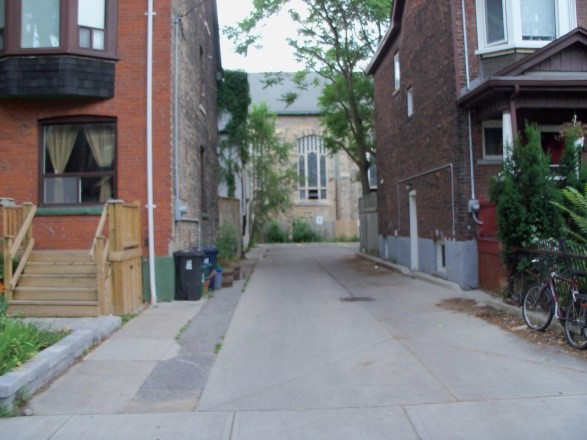
In honour of Ryva Novick (b. March 2, 1938 - d, October 17, 2003) the Founder and Executive Director of The Children's Storefront. It has continually provided child-parent services since 1975, initially at 994 Bathurst at Olive Ave, then from the late 1980s at 1079 Bathurst St. and currently at 826 Bloor St. west. "The chosen lane's proximity to Bathurst is significant for us and that lane, as it extends further north, is a shortcut my mum often used." -Gillian Novick
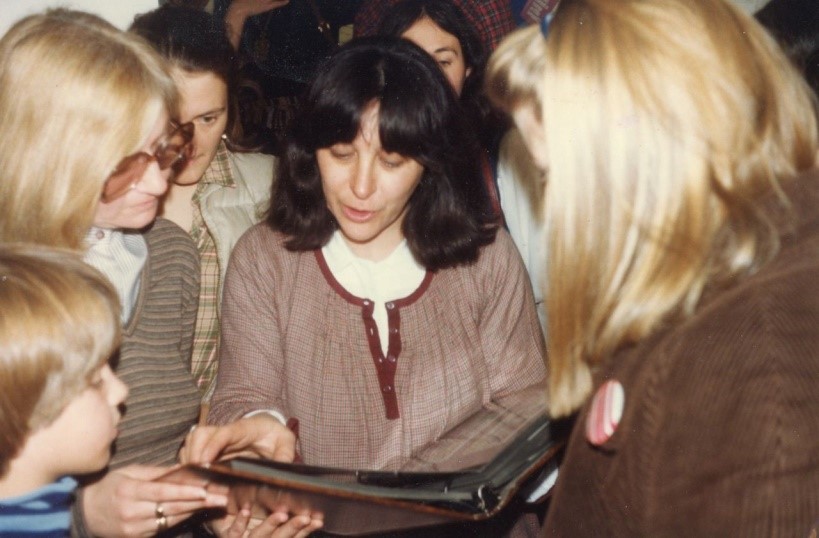
Ryva looking at pix - 10th Anniversary (Photo courtesy of The Storefront)
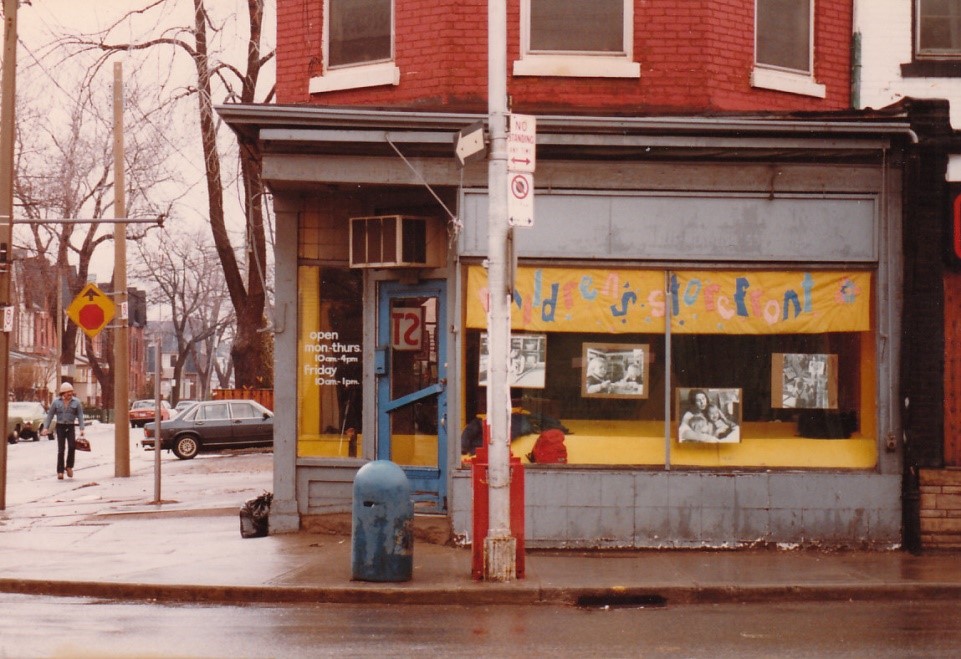
994 Bathurst at Olive c. 1988 (Photo courtesy of Mary Vinci)
Submitted by Karen Hardinge-Brown: My name is Karen Hardinge-Brown. I would like to take a moment of your time to show why I support the naming of the lane in honour of Ryva Novick.
When my son was born almost 30 years ago I noticed the Children's Storefront across the street from where I lived. It took me 10 weeks to get there. I never looked back. Ryva and Mary Ann (Schwartz) were there to welcome me and my new baby. They opened a whole new world for me. They were encouraging and made me realize that this journey was going to be marvelous and I would be okay no matter what the challenge.
Ryva taught me how to see life from a new perspective. To see the world from a child's mind. She taught me not to sweat the small things. All so simple now but this was 30 years ago. I so admired how she was able to see the greatness in everyone who walked through the door. She was encouraging and supportive to everyone.
It is because of her that I have maintained a relationship with the Children's Storefront to this day. I am presently the chair of the Board.
I hope this letter of support helps in your decision.
Yours truly
Karen Hardinge-Brown
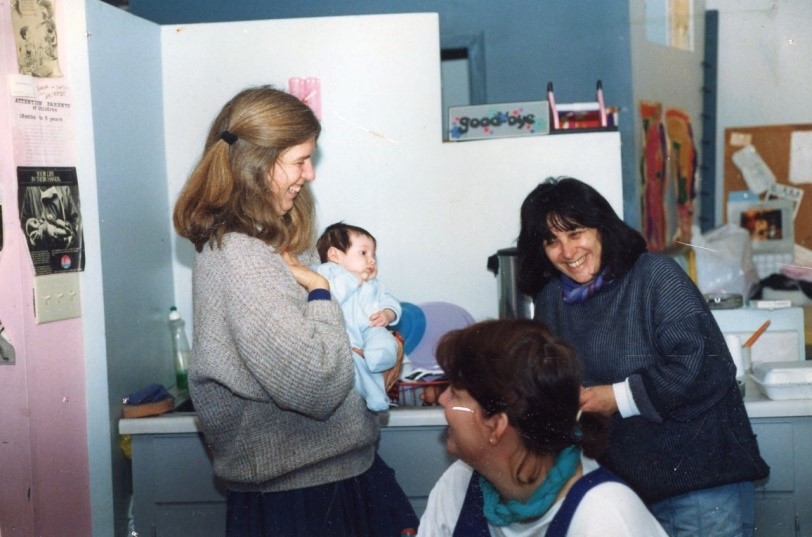
Mary Ann Schwartz and Ryva with baby in kitchen at 1079 (Photo Courtesy of The Children's Storefront)
Submitted by Mary Ann Schwartz: Re: Ryva Novick Lane
I met Ryva Novick when we were both students at the University of Toronto's Institute of Child Study. Ryva and her husband Marvyn Novick were Montrealers with a family of four, transplanted to Toronto.
Because of her background in Early Childhood Education, as well as her own experience of raising children without extended family support, Ryva understood the reality of many Annex families in the same situation.
It was her idea to create a Parent-Child Centre as a network of parents and caregivers. The supportive community thus conceived was the first of its kind in Canada.
As the centre evolved The Children's Storefront became a community-building exercise which expanded into a network of early learning drop-in centres all across the city, the province and the country.
Ryva's idea was an important first in Canada. Recognizing the importance of early learning for infants and toddlers as well as the isolation that families could experience made the joyous get together at The Children's Storefront both profound and transformative fun. Many Annex residents, child and parent, can testify to life-long friendships formed over Sunday Brunch.
I hope you will consider Ryva's significant contribution to Canadian parents and children with her social innovation. A laneway named in her honour would be a wonderful reminder of how she helped build a warmer, more joyous community.
Thank you,
Mary Ann Schwartz
Former Senior Child Care Worker, the Children's Storefront
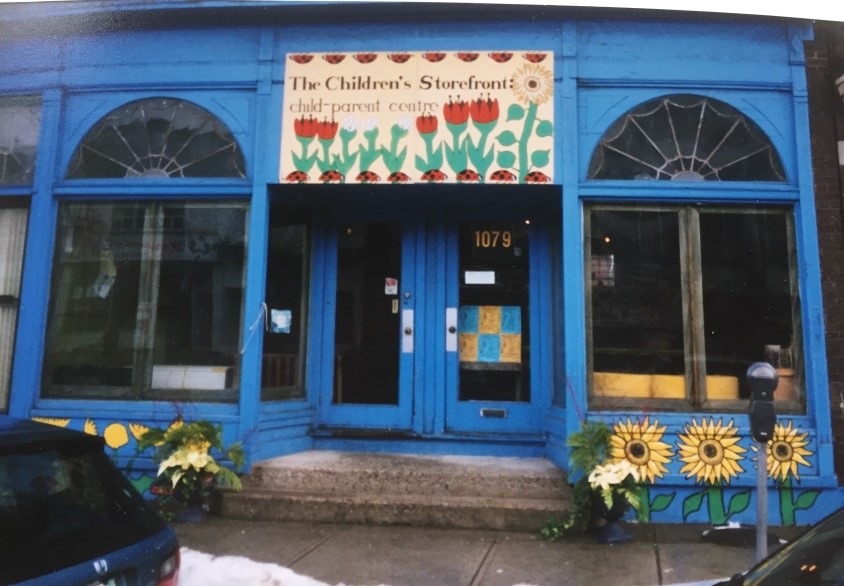
image Storefront 1079 Bathurst c. 2000 (Courtesy Gillian Novick)
Submitted by Gillian Novick, April 11, 2017
Dear Seaton Village Resident's Association,
I was thrilled to learn that community members are proposing a lane be named after my mother. Ryva Novick was the founder and Executive Director of Children's Storefront from 1975 until her death in 2003. The Storefront, as members of the community commonly referred to it, was situated first at 994 Bathurst St. and in the late 1980's moved to 1079 Bathurst St. That is the last location my mother contributed toward. The Children's Storefront still operates in the community over 40 years after its inception!
In the mid 1970's my mother recognized the need for the Storefront and made it. It is hard to separate her from the achievements of the place so I will try to give some highlights about how she created and sustained the Storefront, followed by an excerpt from the foreword, written by my mother, to a publication about the founding principles of the Children's Storefront.
The Storefront's tag-line was 'a meeting place for parents and children' but anyone who went there regularly knew that was just the beginning of what the Storefront offered. Based in strong theoretical ideas about early childhood development and asset-based family support, my mother created a place where a diverse range of families felt welcome, safe and supported. They felt safe expressing the daily challenges and joys of parenting and a public community was formed around the universal needs families have in daily life. My mother set the stage for the Storefront participants to do the connecting they needed at any particular time. Sometimes mutual support between parents/caregivers was helpful while at other times a professional ear and suggestions were offered and occasionally referrals to outside agencies were appropriate. This approach to 'service provision' was reflective of the needs that presented themselves, and in this way was far ahead of its time.
The Storefront was designed to adapt to and be flexible so that users with diverse needs were served together. My mother did this by providing a physical space indoors that gave parents with young children a place to go in all kinds of weather and by offering flexible programming -what we now call 'drop-in'-to ensure the unpredictable schedules of small children could be accommodated. The space appeared casual in its assembly but was actually very carefully planned. For example, adult seating was low to the floor to encourage meeting children at their eye level and to promote adult-child interaction. Effective listening and problem solving and adult-child communication strategies were informally modeled, not explicitly taught, and there were high-quality toys carefully selected for open-ended and developmentally appropriate play. High-quality books for children were a staple and an opportunity for food provision and sharing allowed for loads of delicious fun while also addressing some issues of food insecurity. The Storefront was conceived of as a universal program that should be publically funded and provided without a fee to users. This proved to be difficult at times and my mother worked hard to find enough public funding over the years to sustain the work.
My mother's core value was one of respect. She listened to individuals keenly and shared in their daily lives. She provided feedback and suggestions gently and created a space where families could connect, play, share and form lasting friendships. I have no doubt she has been an influential part of the Seaton Village community and I am very proud of her! If you have any questions or wish for more information please do not hesitate to contact me.
Sincerely,
Gillian Novick
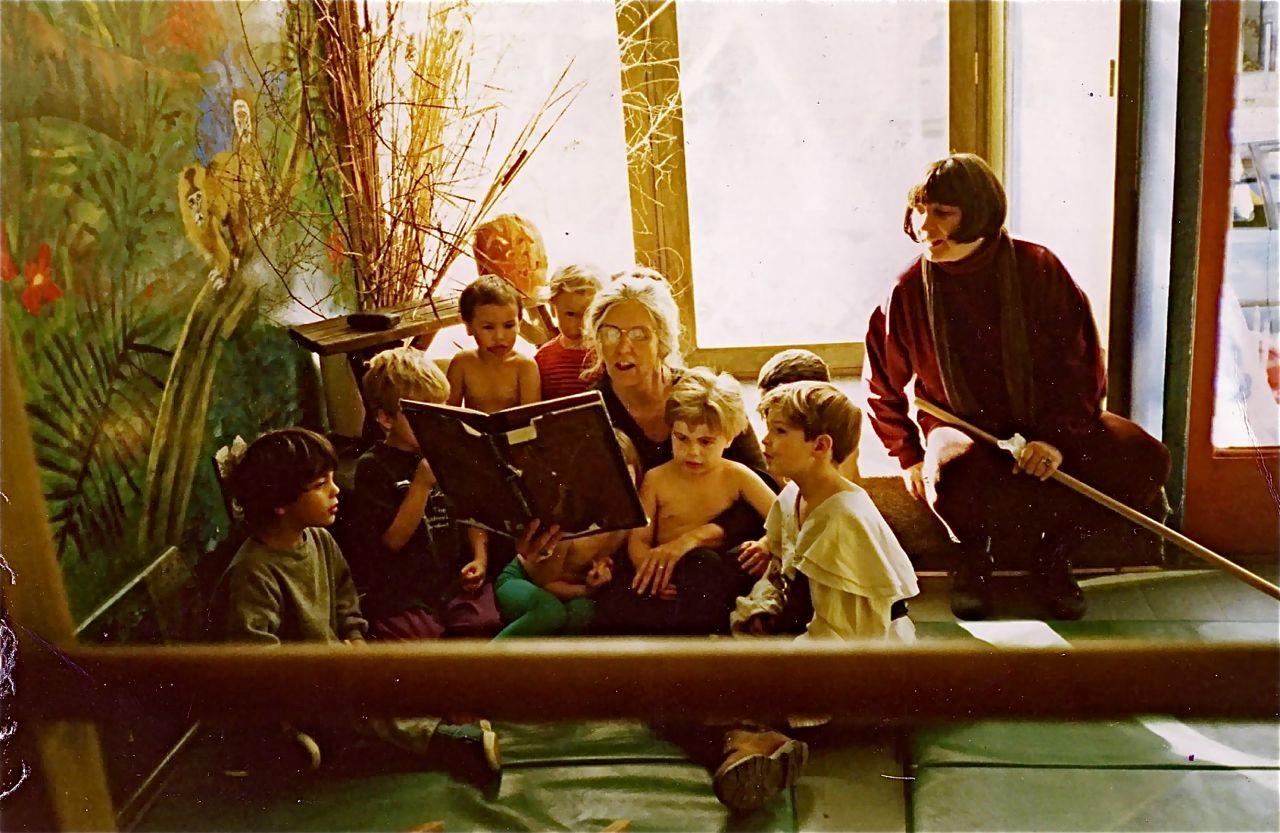 Mary Ann reads at Halloween, Ryva at right at 1079
Mary Ann reads at Halloween, Ryva at right at 1079
(Photo courtesy The Children's Storefront)
Submitted by Karen Kraftchuk:
It was a privilege for me to work with Ryva and MaryAnn and then with Roona and Michelle at The Children's Storefront.
Ryva's vision to create a warm and welcoming place where people looking after young children could gather together came to life at the Storefront.
It broke the cycle of a sense of isolation and loneliness that can often come with being housebound while caring for young children.
It was a natural support to both adults and children alike - the soft cushions and wood kitchen table where people met together lent themselves,
in a natural way, to open dialogue, to play and to the sharing of experiences, often relating to children as they are growing and developing
from newborn to school age and beyond and especially to the building of friendships that extended beyond time spent at the Storefront for both young and old.
Whether a parent, grandparent, caregiver or child, people of diverse ages and backgrounds came together and because of her vision,
the Storefront was a place of acceptance and belonging. The definition of lane is the passage between:
Ryva created a place where people came and passed through at a certain time in their lives, sharing their stories and challenges and vibrant presence.
Parents, who themselves experienced the Storefront as children, come back now with children of their own; this is Ryva's timeless legacy.
We shared so much laughter there; Ryva had a wonderful sense of humour and she had the ability to make one feel that all the ups and downs of life were a natural part of life experience. It enriched my life to know and work with her and with all the amazing people I met there. This is a beautiful way to honour her and for others to know her name. Karen Kraftchuk, Former Senior Parent Child Worker, The Children's Storefront
TRAGIC LOSS:
On Monday, October 31, 2009, a fatal fire destroyed the 1079 Bathurst location and reports about the death of Marie Speck,
age 50, living above the Storefront, both credited her with alerting tenants and suspected her of careless smoking.
Several reports from the time are linked below.
https://toronto.ctvnews.ca/body-found-in-bathurst-st-fire-s-rubble-1.450337
https://www.thestar.com/news/gta/2009/11/04/community_strength_lost_in_childrens_storefront_blaze.html
Further Information: Cover design by Emma Hesse from The Children's Storefront: A Child-Parent Centre; A Report on the history, development and functions of the Children's Storefront, (1980) University of Toronto Press.
Foreword There are a number of important principles implicit in the development of the Children's Storefront. The Storefront evolved into the role that it assumes in the community today. It was not limited in the beginning by a fixed idea of what it should be, even though its purpose - to be a source of support to parents and young children - has remained the central focus.
The Storefront began as a toy lending centre. During the process of that operation, parents conveyed the need for a community service that could offer a wider range of support. The Storefront did not ask itself whether it was to be a social service, recreation service, education centre, or community mental health program. Rather, it responded to the needs that were crucial to families.
The provision of a community meeting place with opportunities for sustaining social contact on a daily basis emerged as a fundamental need for parents. The Storefront has thus become a public household in which a diversity of people feel comfortable living thought their daily experiences as parents, where very young children acquire social world, and where parents in crisis are accepted as part of the continuum of family life.
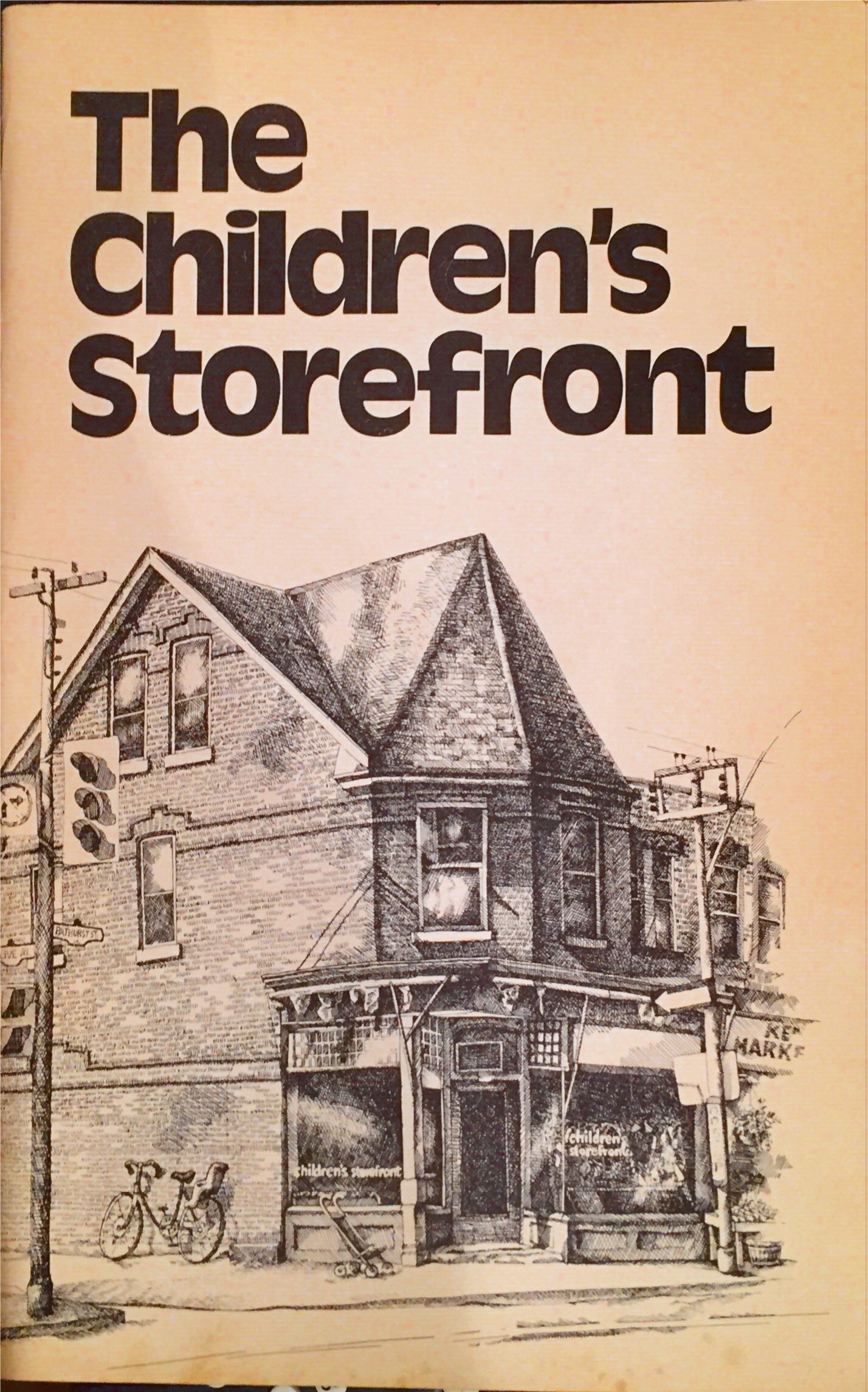
Cover design by Emma Hesse from The Children's Storefront: A Child-Parent Centre;
A Report on the history, development and functions of the Children's Storefront, (1980) University of Toronto Press.
Foreword
There are a number of important principles implicit in the development of the Children's Storefront. The Storefront evolved into the role that it assumes in the community today. It was not limited in the beginning by a fixed idea of what it should be, even though its purpose - to be a source of support to parents and young children - has remained the central focus.
The Storefront began as a toy lending centre. During the process of that operation, parents conveyed the need for a community service that could offer a wider range of support. The Storefront did not ask itself whether it was to be a social service, recreation service, education centre, or community mental health program. Rather, it responded to the needs that were crucial to families.
The provision of a community meeting place with opportunities for sustaining social contact on a daily basis emerged as a fundamental need for parents. The Storefront has thus become a public household in which a diversity of people feel comfortable living thought their daily experiences as parents, where very young children acquire social world, and where parents in crisis are accepted as part of the continuum of family life.